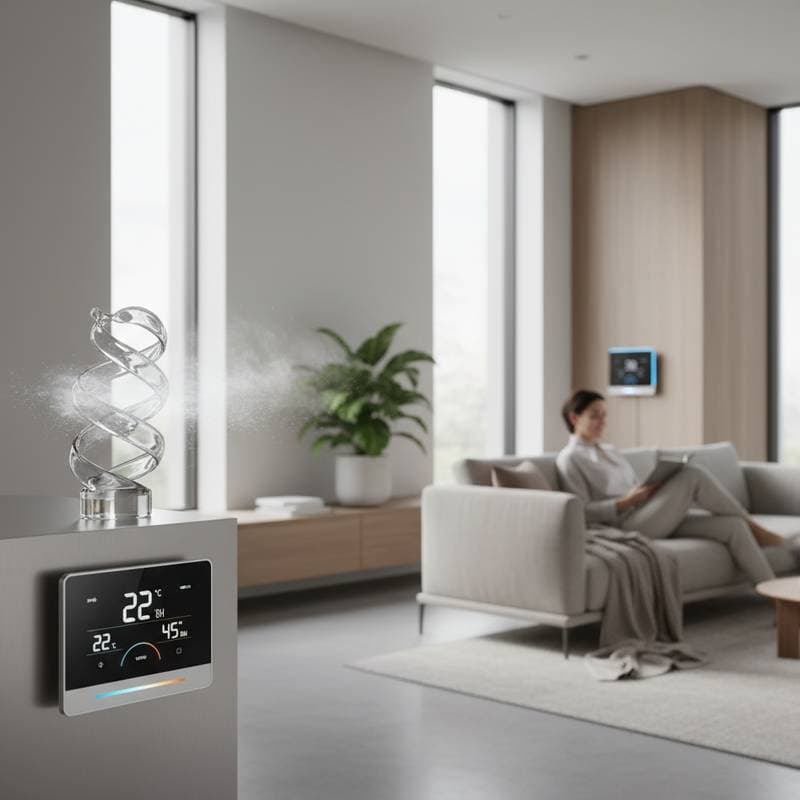Understanding Humidity's Role in Preventing Mold and Allergies
Humidity often escapes notice, yet it profoundly affects home comfort and health. Professionals in heating, ventilation, and air conditioning observe that levels exceeding 50 percent create conditions ripe for mold proliferation and allergen buildup. Homeowners may experience sticky atmospheres, persistent odors, or respiratory discomfort as early indicators of imbalance.
In areas with seasonal humidity fluctuations, maintaining equilibrium proves essential. Beyond mere comfort, proper humidity management safeguards structures, improves air purity, and supports family health. Modern systems address these concerns by targeting moisture directly, halting issues at their source.
The Invisible Effects of Excess Moisture
Humidity influences more than sensation; it shapes indoor ecology. Low levels dry mucous membranes, while excess promotes microbial growth. In humid climates, moisture infiltrates via foundations, roofs, and ventilation paths, persisting despite cooling efforts.
Standard air conditioners prioritize temperature reduction over dehumidification, leading to residual dampness on surfaces and within equipment. Mold spores, ubiquitous in small quantities, activate within 24 to 48 hours under such conditions. Resulting allergens provoke symptoms like sneezing, coughing, and eye irritation, exacerbating conditions for sensitive individuals.
Addressing the Core Issue with Targeted Solutions
Extended air conditioner operation provides partial relief but fails to resolve persistent moisture. These units focus on cooling, not extraction, straining systems and elevating costs without achieving optimal comfort.
Dedicated dehumidification integrates with existing setups to sustain 40 to 50 percent humidity. This range ensures refreshing air while inhibiting mold, mildew, and mite activity. Professionals view such controls as integral to comprehensive home maintenance, enhancing efficiency and breathability.
Scientific Insights into Mold and Allergen Dynamics
Mold thrives on moisture, nutrients, and moderate temperatures, with humidity above 60 percent accelerating colonization of materials like drywall and fabrics. Dust mites, key allergens, rely on ambient moisture for survival; levels below 50 percent suppress their numbers effectively.
These factors underscore humidity regulation as a primary defense, surpassing reliance on filtration alone. Understanding these mechanisms empowers proactive measures against health risks.
Proven Steps for Effective Humidity Management
Targeted interventions yield swift results. Follow these professional recommendations to mitigate mold and allergens promptly.
1. Measure Current Humidity
Acquire a digital hygrometer for accurate readings across rooms. Levels consistently above 55 percent signal elevated risk; track variations to inform adjustments.
2. Examine High-Moisture Areas
Focus on basements, bathrooms, kitchens, and laundry spaces, sources of daily vapor. Identify condensation, stains, or discoloration as evidence of accumulation requiring attention.
3. Install Whole-Home Dehumidification
These units connect to HVAC systems, removing moisture centrally before distribution. Unlike portables, they ensure uniform coverage; expect installation costs of $1,500 to $3,000, offset by long-term savings and benefits.
4. Optimize Ventilation
Employ exhaust fans during moisture-generating tasks and confirm dryer exhaust routes outdoors. Facilitate airflow by opening doors, preventing humid stagnation.
5. Secure Building Envelope
Detect and seal gaps in windows, foundations, and ducts through inspection. Add insulation to attics and lines for stable conditions throughout the structure.
6. Service HVAC Regularly
Clogged coils or drains retain moisture internally. Biannual professional checks, plus annual tune-ups, prolong equipment life and reduce energy use by up to 15 percent.
Indicators of Emerging Problems
Humidity imbalances manifest visibly over time. Persistent musty scents, surface spots, window condensation, allergy intensification, or material distortion demand immediate response.
Hidden growth within walls or ducts precedes surface evidence. Early detection averts extensive damage and health impacts.
Tailoring Solutions to Your Home
Customization based on size, design, and locale maximizes efficacy. Consider these aspects for informed implementation.
Investment and Returns
Initial expenses for dehumidifiers recoup via reduced cooling demands and maintenance. Balanced conditions shorten cycles, yielding 10 to 20 percent savings on bills while minimizing deterioration.
Health and Safety Priorities
Mold spores compromise respiration; avoid self-remediation in systems to prevent dispersal. Engage specialists for thorough, safe resolution.
Installation Best Practices
Technicians ensure code compliance, adequate drainage, and seamless integration. Confirm credentials to guarantee quality workmanship.
Year-Round Adaptations
Summer emphasizes moisture removal; winter may require humidification against aridity. Automated sensors in thermostats maintain optimal levels effortlessly.
Maintenance Tips for System Longevity
- Replace filters routinely to sustain airflow and deter internal mold.
- Inspect drain lines monthly for unobstructed flow.
- Clear debris from outdoor components for optimal performance.
- Arrange yearly professional servicing to catch issues early.
- Use monitoring devices for real-time alerts on deviations.
Broader Benefits of Balanced Indoor Air
Effective humidity control elevates daily living. Residents report improved clarity, rest, and vitality amid fresher surroundings.
Assets endure longer without warping or mildew, from furnishings to documents. This approach fosters enduring structural health and occupant wellness.
Implementing Change for Lasting Comfort
Dampness, allergies, or mold signal the need for humidity intervention. Aligning air quality with comfort creates resilient indoor spaces.
Commence with a professional assessment to map moisture patterns and customize solutions. Sealing, equipping, and servicing culminate in a mold-resistant, allergen-minimized haven.
Frequently Asked Questions
Q: How do I determine if a dehumidifier is necessary?
A: Readings above 55 percent humidity, coupled with odors, condensation, or symptoms, indicate need. Experts assess levels and size systems accordingly.
Q: What constitutes optimal indoor humidity?
A: Target 40 to 50 percent to inhibit mold and mites while preserving comfortable, non-drying air.



